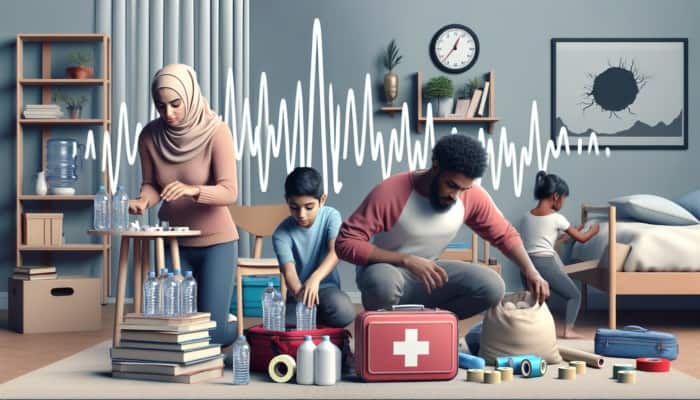Essential Preparations for Earthquake Aftershocks: A Comprehensive Guide
Following an earthquake, the ground may continue to tremble, resulting in aftershocks that can significantly jeopardise safety and property integrity. Preparing for these subsequent seismic events is crucial, as effective earthquake aftershock prep can substantially reduce the associated risks. By being proactive and informed, individuals and families can protect themselves and their belongings from the dangers of aftershocks.
Why Immediate Action Is Crucial After an Earthquake

The moments right after the initial tremor are pivotal. Taking immediate action can drastically reduce the risks of aftershocks, which typically manifest within days or weeks following the main event. Recognising that aftershocks can inflict similar levels of damage is essential for effective preparedness. A well-prepared household understands how to react quickly to safeguard its health and that of its loved ones.
After experiencing an earthquake, it is imperative to remain vigilant and reassess your environment. Look for potential hazards such as fallen objects, gas leaks, or damaged structural components. By acting swiftly and decisively, you can enhance your safety and that of those nearby, thus establishing a solid foundation for comprehensive earthquake aftershock prep.
Key Items to Include in Your Emergency Kit
A meticulously planned emergency kit is fundamental to efficient earthquake aftershock prep. Essential components of your kit should encompass:
– Water: Ensure you have one gallon per person daily for at least three days.
– non-perishable food: Stock enough food for at least three days, including ready-to-eat meals.
– First Aid Supplies: A thorough kit that can address common injuries and ailments.
– Communication Tools: Battery-operated radios, mobile phones, and their respective chargers.
– Flashlights: These are equipped with additional batteries to illuminate your surroundings in case of power failures.
These items must be readily accessible and routinely checked to confirm they remain functional and unexpired.
The Importance of Drills and Training for Aftershocks
Regularly conducting preparedness drills is an integral part of earthquake aftershock prep. Involving the entire family in these exercises ensures that every member knows the appropriate actions to take during an aftershock. Practice essential techniques such as drop, cover, and hold on, along with simulating evacuation scenarios to reinforce established safety protocols.
Training should not be confined to just the family unit; consider participating in community workshops focusing on earthquake readiness. The more familiar you and your neighbours become with emergency procedures, the better equipped you will be to react effectively when the ground begins to shake once more.
Establishing Effective Communication Plans During Aftershocks

Creating clear, reliable communication strategies is crucial during aftershocks. Families should designate a primary contact person located outside the immediate vicinity. This individual can facilitate coordination efforts and check on the safety of family members.
Utilising mobile phones, social media platforms, and local emergency services can significantly enhance communication efficiency. Ensure that all family members are proficient in using these tools effectively, including knowing specific meeting points to regroup in the event of separation.
Gaining Insight into Earthquake Aftershock Patterns
Acquiring knowledge about the characteristics of aftershocks is vital for effective earthquake aftershock prep. These tremors can be erratic, and understanding their patterns can facilitate better preparations.
Understanding the Causes of Aftershocks
Aftershocks occur due to stress redistribution along fault lines after a significant earthquake. When the Earth's crust shifts, it establishes a new equilibrium, and the energy released frequently results in smaller seismic events referred to as aftershocks. This process can persist for an extended duration, sometimes stretching for weeks or months following the initial quake.
Estimating the Likelihood of Aftershock Occurrences

While accurately predicting the timing and intensity of aftershocks remains a formidable challenge, scientists leverage historical data and seismic activity trends to assess their probability. Researchers can provide forecasts that assist communities in their preparedness efforts by analysing past earthquakes and their respective aftershocks.
Recognising that aftershocks may occur in clusters can be instrumental in formulating response strategies. Staying informed through trustworthy sources will enhance your earthquake aftershock prep initiatives.
Understanding the Duration and Frequency of Aftershocks
The duration and frequency of aftershocks can vary considerably. Generally, the most substantial aftershocks will likely occur within a few days after the primary earthquake; however, more minor tremors may persist for months. This ongoing seismic activity necessitates a sustained state of alertness for residents in affected regions, underscoring the need for robust preparedness measures.
The Impact of Aftershocks on Structural Integrity
The threat of structural damage from aftershocks is particularly pronounced for buildings that have already suffered damage during the initial earthquake. Repeated shaking can exacerbate existing vulnerabilities, potentially leading to additional collapses. This reality emphasises the necessity of preparing for aftershocks and ensuring that buildings are reinforced to withstand seismic forces effectively.
Strategies for Preparing Your Home Against Aftershocks
A robust home preparedness plan is central to effective earthquake aftershock prep. Enhancing your residence's resilience can safeguard your family and property during subsequent tremors.
Securing Furniture and Appliances to Minimise Risks
Securing furniture and appliances is one of the most effective ways to safeguard your home. Utilise brackets, straps, and wall anchors to prevent items from toppling during aftershocks. Ensure that heavy furniture, such as bookcases, is anchored securely to walls, and place large appliances away from high-traffic areas where they could pose a risk of injury if they fall.
Reinforcing Your Home's Structural Integrity
Consider retrofitting your residence to enhance its capacity to endure seismic activity. Hiring a professional to evaluate your home’s structural integrity can identify weaknesses and recommend improvements. These may include bolting the foundation, reinforcing walls, or upgrading roofing materials to better withstand the forces generated by aftershocks.
Establishing Safe Zones Within Your Home
Designate specific areas in your home where family members can safely congregate during aftershocks. These safe zones should be located away from windows, heavy furniture, and potential hazards that could cause a fall. Ensure all household members know these locations and regularly practice drills to reinforce their importance.
Conducting Regular Inspections for Gas and Water Leaks
Routine inspection of utility lines is crucial in earthquake aftershock prep. Aftershocks can potentially rupture gas lines or water pipes, resulting in hazardous leaks. Familiarise yourself with the locations of gas shut-off valves and ensure that all family members are trained to turn off utilities swiftly in an emergency.
Comprehensive Emergency Kits: Essential Supplies for Aftershocks
A well-equipped emergency kit is vital for thorough earthquake aftershock prep. Ensuring you have the appropriate supplies can significantly influence your ability to cope with the aftermath of an earthquake.
Water and Non-Perishable Food Essentials
Water and non-perishable food should form the foundation of your emergency supplies. Aim to have at least three days' worth of food and water per person. Opt for non-perishable items such as canned goods, dried fruits, nuts, and granola bars. For convenience, remember to include a manual can opener in your kit.
First Aid Kits and Necessary Medications
A thoroughly stocked first aid kit is indispensable for treating injuries that may arise during aftershocks. Your kit should include bandages, antiseptics, pain relief medications, and any personal prescriptions you or your family members may need. Regularly verify and refresh your kit to ensure all items are functional and within their expiration dates.
Tools and Supplies for Prompt Repairs
Keep bare essentials and materials readily available for quick repairs after an earthquake. Items such as hammers, nails, screwdrivers, and duct tape can prove invaluable for addressing minor damages. Additionally, consider including tarps or plastic sheeting to protect your home from the elements until you can conduct more extensive repairs.
Communication Devices and Backup Batteries
Maintain communication devices, including battery-operated radios, mobile phones, and chargers, in an easily accessible location. Ensure that extra batteries are available for all devices in your emergency kit. Remaining informed about aftershocks and other crucial updates is essential for ensuring safety during uncertain situations.
Safety Strategies for Families During Aftershocks
Families can undertake proactive measures to enhance their safety during aftershocks. By educating and preparing together, households can effectively navigate the challenges posed by these subsequent tremors.
Educating Children About Aftershocks
Educating children is vital for helping them comprehend the risks associated with aftershocks. Teach them what actions to take and where to go during an aftershock. Use simple language and practical demonstrations to ensure they grasp the concepts.
Conducting Family Safety Drills
Regular family drills reinforce safety plans and foster confidence. Schedule practice sessions to familiarise everyone with the established protocols, including drop, cover, and hold on drills, evacuation routes, and designated meeting points.
Establishing a Family Meeting Point
Select a safe location outside your home as a family meeting point. This becomes crucial if family members become separated during an aftershock. Ensure all family members know the meeting point and understand how to reach it quickly and safely.
Maintaining Composure During Aftershocks
Remaining calm during an aftershock ensures safety. Encourage each family member to follow the safety plan without panicking. Practising mindfulness techniques can aid in maintaining composure and facilitate effective decision-making during stressful circumstances.
Building Community Preparedness for Earthquake Aftershocks
Community preparedness is fundamental in bolstering resilience against aftershocks. By collaborating, neighbourhoods can create a robust support network.
Implementing Neighbourhood Watch and Alert Systems
Establishing neighbourhood watch programmes and alert systems can efficiently inform residents about potential aftershocks. These systems enable quick communication and collaboration among neighbours, enhancing the community's overall safety.
Forming Community Emergency Response Teams
Training local volunteers to establish Community Emergency Response Teams (CERT) can significantly enhance response capabilities during and following seismic events. These teams can assist with first aid, search and rescue operations, and disseminate vital information, ensuring community members are adequately prepared for potential aftershocks.
Sharing Resources and Information Within the Community
Pooling resources and sharing information among community members strengthens overall preparedness. Neighbours can collaborate on emergency kits, exchange knowledge about safety practices, and offer emotional support during challenging times.
Coordinating Efforts with Local Authorities
Collaborating closely with local authorities enhances community preparedness. Establishing connections with emergency services can facilitate better coordination during crises. Participate in community planning sessions to stay updated on regional initiatives to improve disaster readiness.
The Psychological Effects of Earthquake Aftershocks
Aftershocks can profoundly impact the psychological well-being of individuals and communities. Addressing these challenges is crucial for holistic preparedness.
Recognising Common Emotional Reactions to Aftershocks
Feelings of fear, anxiety, and stress are normal responses to aftershocks. Acknowledging these emotional reactions is the first step in addressing them effectively. It is essential to recognise that these feelings are valid and commonly experienced by many within the community.
Strategies for Coping with Aftershock Anxiety
Implementing coping strategies can assist individuals in managing anxiety related to aftershocks. Deep breathing, mindfulness practices, and positive visualisation can offer immediate relief. Open discussions about feelings in family and community circles foster connection and support.
Seeking Professional Guidance
Do not hesitate to consult mental health professionals if feelings of anxiety and stress become overwhelming. Professional support can provide coping strategies and therapeutic techniques to help individuals healthily process their experiences and emotions.
Fostering Community Support During Aftershocks
Community support is vital in coping with aftershocks. Encourage neighbours to check on one another, share resources, and provide emotional assistance. Establishing a strong community network can help individuals feel less isolated and more empowered when facing challenges.
Understanding Aftershock Insurance: Key Information to Consider
Grasping the intricacies of insurance coverage for aftershocks is a critical aspect of earthquake aftershock prep. Securing the right policy can provide both peace of mind and financial protection.
Exploring Types of Aftershock Insurance Coverage
Various insurance policies offer differing levels of coverage for aftershocks. While homeowners insurance may cover certain damages, specialised earthquake insurance policies can provide additional safeguards. Carefully review your policy to understand what is included and what is excluded, especially in relation to aftershocks.
Assessing Your Insurance Coverage Needs
Evaluating your home and personal belongings is essential for determining appropriate insurance coverage. Consider the value of your property and assets, and consult with an insurance agent to ensure you have sufficient coverage for potential aftershock damages.
Steps for Filing Claims Following an Aftershock
Understanding the steps to take when filing an insurance claim after an aftershock is vital for ensuring a smooth claims process. Document damages with photographs and detailed descriptions, and promptly report them to your insurance company. Familiarise yourself with the claims process specific to your policy to avoid any potential complications.
Choosing the Right Insurance: Key Considerations
When selecting an insurance policy, consider aspects such as coverage limits, deductibles, and the insurance provider's reputation. Conduct thorough research on different policies and read reviews to ensure you choose a plan that effectively meets your needs.
Frequently Asked Questions About Aftershocks
What are aftershocks?
Aftershocks are smaller seismic events that occur following a major significant earthquake. They arise from the Earth's crust, adjusting to the changes brought about by the initial quake.
How long do aftershocks typically last?
Aftershocks can continue for weeks or even months after the main earthquake, with the most significant aftershocks usually occurring within the initial few days.
What should I include in my emergency kit for aftershocks?
Your emergency kit should comprise water, non-perishable food, a first aid kit, communication devices, and repair tools.
How can I effectively prepare my home for aftershocks?
To prepare your home, secure heavy furniture, reinforce its structural integrity, create safe zones, and routinely inspect for gas and water leaks.
What emotional responses are common after experiencing aftershocks?
Feelings of fear, anxiety, and stress are common emotional responses to aftershocks, as individuals may feel uncertain about their safety and the stability of their environment.
How can I support my family during aftershocks?
Educate your family about earthquake safety, conduct regular drills, establish a meeting point, and encourage open discussions about feelings and concerns.
What types of insurance provide coverage for aftershocks?
Homeowners insurance may cover certain damages, but specialised earthquake insurance policies can offer additional protection for damages caused by aftershocks.
How can I determine if I need additional earthquake insurance coverage?
Assess the value of your home and belongings, and consult with an insurance agent to ascertain whether your current coverage is adequate.
What is the best way to stay informed during aftershocks?
Maintain battery-powered radios, mobile phones, and other communication devices that are readily available to receive updates and alerts from local authorities.
Are there community resources available for aftershock preparedness?
Many communities provide resources such as emergency response teams, workshops, and local emergency planning sessions to enhance preparedness for aftershocks.
Explore our world on X!
SHTF Security Measures: Key Strategies for Preparedness
Essential Guidelines for Effective SHTF Security Measures Deepening Your Understanding of Key Security Concepts SHTF Security Measures: To implement successful SHTF security measures, a comprehensive understanding of foundational concepts is crucial. This includes proactive planning, resource management, and risk assessment. In times of uncertainty, the capacity to foresee and react to potential threats becomes vital. By adopting […]
Emergency Sleeping Bags: Essential for Outdoor Emergencies
Comprehensive Guide to Emergency Sleeping Bags Exploring the Essential Features of Emergency Sleeping Bags Emergency Sleeping Bags: These bags are invaluable resources designed to provide vital warmth and protection during unforeseen events. These bags are usually made from lightweight, waterproof materials, providing excellent insulation while safeguarding users from harsh weather. Their innovative design frequently includes […]
Post-Disaster Bartering: Essential Strategies
Exploring the Concept of Post-Disaster Bartering What Is the Concept of Post-Disaster Bartering? Post-Disaster Bartering: Post-disaster bartering refers to the exchange of goods and services that occurs when conventional currency systems collapse due to catastrophic events, such as natural disasters, economic crises, or societal upheavals. During these critical moments, individuals and communities utilise the resources […]
Hurricane Generator Use: Powering Through Storms
Maximising the Benefits of Hurricane Generator Usage What Exactly Are Hurricane Generators? Hurricane Generator Use: Hurricane generators are advanced power supply devices specifically engineered to deliver electricity during extreme weather events, particularly during hurricanes, when standard power infrastructures may fail. These robust machines ensure that both residential and commercial establishments receive the power they need, […]








This is such an important topic, especially for those of us living in earthquake-prone areas. I remember after a sizable quake a few years back, the aftershocks had everyone on edge. It really struck me how vital it is to have a plan in place before shaking even starts.
You hit the nail on the head with that one. Aftershocks can be like that annoying friend who doesn’t take the hint and keeps popping by—totally uninvited. Having a plan is definitely key, and it helps keep everyone a little sane when the ground starts playing musical chairs.
Your emphasis on the immediacy of action following an earthquake really resonates with the central theme of preparedness. It’s indeed remarkable how so many people underestimate the potential for aftershocks, often viewing the initial quake as the climax of seismic activity. Yet, as you pointed out, the reality is that the danger does not end with the first tremor. Personally, I have experienced minor quakes that left me feeling rattled and anxious, underscoring just how crucial it is to have a plan in place.
This post couldn’t have come at a more pertinent time! Living in an area prone to earthquakes, I’ve often felt the disorienting effects of both the initial shake and the aftershocks that follow. Your emphasis on immediate action and preparedness resonates deeply with me. I vividly recall the day of a moderate quake a few years back. In the moments right after, it struck me how unprepared I was for the aftershocks. I remember standing in my living room, frozen, as I tried to gauge whether it was wise to seek safety outside or to hunker down.
You raise an excellent point about the importance of immediate action after an earthquake. I remember reading about how communities with established emergency plans were able to respond much more effectively after the 2010 Haiti earthquake. Those who had practiced drills and had supplies readily accessible reported feeling more secure, which is crucial during those terrifying moments when aftershocks can strike.
This is such an important topic, especially for those of us living in earthquake-prone areas. I remember going through an earthquake a few years back, and the moments after felt incredibly chaotic. It was surprising to realize how the initial shock settled into a sense of uncertainty about what could happen next.